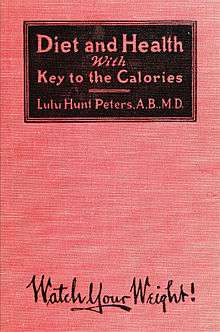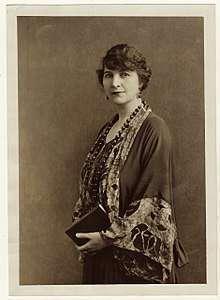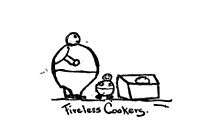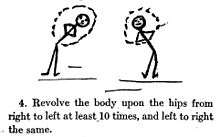Lulu Hunt Peters
Lulu Hunt Peters (1873–1930) was an American doctor and author who wrote a featured newspaper column entitled Diet and Health, which she followed up with a best-selling book, Diet & Health: With Key to the Calories. She was the first person to widely popularize the concept of counting calories as a method of weight loss.[1][2] It was also the first weight-loss book to become a bestseller.[3]


Early life and education
Lulu E. Hunt was one of three children born to Thomas and Alice Hunt of Milford, Maine. She attended the Maine State Normal School in Castine before moving to California.[4] She married Louis H. Peters in Los Angeles in 1899, and in 1909 graduated as a Doctor of Medicine from the University of California.[5][6]
Career
For a number of years, Dr. Hunt wrote a featured newspaper column entitled Diet and Health for the Central Press Association, which supplied content for about 400 newspapers nationwide.
In 1918, she published the diet book Diet & Health: With Key to the Calories, named after and based on her column and with illustrations by her nephew, Dawson Hunt Perkins (1907-1976), son of Henry Addison Perkins, Jr. and Anna Lydia Hunt).[7] It presented the concept of calorie reduction as the best form of weight loss/watching weight to American women, who were wanting to conform to the new-found body image "thin is in". Along with presenting a solution for American women, Peters suggested that weight control was an active form of patriotism in the context of World War I. She suggested that dieting meant having complete self-control and recommended that women organize Watch Your Weight Anti-Kaiser Classes to obtain it.[7] Peters followed her own advice/health regimens and credited them, along with her regular attendance at women's suffragist rallies, for her health and self-sufficiency.
Shortly after her book was published, Peters traveled to Bosnia, where she served with the Red Cross. When she returned to the United States, she was pleasantly surprised to learn that she was a best-selling author. She published a later edition describing her life after the book. Beginning in 1922, Peters became a radio lecturer, giving a series of talks about diet and health over station WJZ, then in Newark NJ.[8] She continued to give radio health talks for the next several years.[9] In addition, she also was a popular public speaker, giving motivational talks all over the United States, including at facilities that specialized in weight loss.[10] And she made informational pamphlets available to the readers of her syndicated columns; those who sent for these pamphlets received Peters' strategies for how to successfully lose weight.[11]
In 1930, while on a trip by steamship to a medical conference in London, she became ill with neuralgia, and her condition worsened during the trip.[12] She died of pneumonia in late June, 1930.[13] She was survived by her former husband Louis H. Peters.[14] Her book remains in circulation and is still quoted today.[15]
Diet and Health: With Key to the Calories


Having grown up a hefty child and once weighing 220 lbs, she was extremely conscious of the problems weight presented to her. Peters' book Diet and Health: With Key to the Calories,[16] targeted specifically to American women, became extremely popular, selling 2 million copies. People found it witty and entertaining.[3] The book was the first dieting book to become a bestseller, and it remained in the top ten non-fiction bestselling books from 1922 to 1926,[3] topping the list for two years running, in 1924 and 1925.[7]
In the book, she explained the concept of the calorie as a scientific unit of measurement of the energy potentially available from food.[2] The concept of the calorie was so new that her book even provides instruction on the word's pronunciation. She explains the importance of balancing food intake and energy used, and suggests a number of exercises, supported with simple cartoons.
She explains in her book that "hereafter you are going to eat calories of food. Instead of saying one slice of bread, or a piece of pie, you will say 100 calories of bread, 350 calories of pie".[3] She shows women how to calculate their ideal weight with a formula. Her book included estimates of food portions that would contain 100 calories, based on research in a variety of technical publications that were not available to the general reader. She also indicates how many calories someone should eat per pound of ideal body weight, to keep the ideal weight that her system suggests (similar to body mass index). She paid less attention to issues of what sorts of foods a person should eat. Under her system, a person of Peters' height could eat whatever she wanted, as long as she maintained a strict diet of 1,200 calories a day. However, she warned against eating candy, because she thought that women who ate a little candy would binge on it.[3]
In the 19th century and the beginnings of the 20th century, the main concern among nutrition experts was that people, especially poor laborers, were undernourished, and the main goal was to find inexpensive ways to supply enough food energy.[3] Especially after World War One, the main concern among women, and the main concern for Peters, was being slender.[3] Her book reinforced the message that the fashion industry (Vogue, Chanel, etc.) was implying through the design of their clothing: being fat was no longer in style.[6] Peters presented a solution: counting calories as a way to lose weight. The book was written with the mindset that all women wanted to lose weight. According to Peters, who had lost 50-70 lbs with her diet regimen, dieting meant being beautiful and being in total control of the self. Being thin, to Peters, was an issue of self-esteem as well as physical health. She captivated her readers by letting them know that she knew the shame in being fat (having once weighed 200 lbs), and the sacrifice that dieting entailed, first hand. Beyond this, however, Peters saw dieting as having a moral dimension. She saw people who did not have control over their weight as morally suspect. In order to be thin, women must resist temptations, which she explains with the language of sin, punishment, and redemption.[3]
She also mentions other reasons, beyond self-improvement, that made her diet even more appealing. During World War I, rationing was a regular part of daily life. Peters suggested that her diet would make dealing with rationing easier. For instance, she said that women who count their calories will be able to leave the left-over rations for children during the war. She stated, "that for every pang of hunger we feel we can have a double joy, that of knowing we are saving worse pangs in some little children, and that of knowing that for every pang we feel we lose a pound." The diet would also help prevent food shortages; by counting calories, women would be showing patriotism and improving themselves at the same time.
References
- Jou, Chin (2007-10-11). "Your Stomach Must Be Disciplined": Lulu Hunt Peters and the Beginnings of Calorie-Counting in Corporeal Self-Regulation, 1918-1924. Annual Meeting of The American Studies Association. Philadelphia Marriott Downtown, Philadelphia, PA. Retrieved 17 October 2013.
- Gruber, Beth (2002-07-27). "The History of Diets and Dieting Part V The First Low Calorie Plan". CarbSmart. Retrieved 17 October 2013.
- Kawash, Samira (2013). Candy: A Century of Panic and Pleasure. New York: Faber & Faber, Incorporated. pp. 185–189. ISBN 9780865477568.
- Biographical index, Ancestry.com, accessed June 23, 2014.
- Frederic J. Haskins. "Answers to Questions." (Jersey City NJ) Jersey Journal, December 10, 1930, p. 22.
- Jou, Chin. "Counting Calories". Chemical Heritage Magazine. Chemical Heritage Foundation. Retrieved 25 March 2018.
- Temple, Emily (January 15, 2019). "Some Hilarious Illustrations from America's First Bestselling Diet Book". LitHub.
- "Radio Listings for Station WJZ." Washington DC Evening Star, July 24, 1922, p. 15.
- "Radio Listings for Station WJZ." Trenton (NJ) Evening Times, January 10, 1925, p. 10.
- Lulu Hunt Peters. "A Good Way to Stop That Craving." Aberdeen (SD) Daily News, January 3, 1928, p. 4.
- Lulu Hunt Peters. "Diet and Health." Dallas Morning News, June 21, 1926, p. 6.
- "Eminent Doctor and Dietician is Dead." Oshkosh (WI) Northwestern, June 28, 1930, p. 5.
- "Dr. Lulu Peters, Star Writer, Dies on London Visit". The Daily Star, Queens Borough. June 30, 1930.
- "Dr. Peters Remembers Her Former Husband." Trenton (NJ) Evening Times, July 16, 1930, p. 16.
- Susan Cahalan. "Weight of the World: Since We First Stopped Running for our Food, We've Been Obsessed with Fighting Fat." New York Post, February 5, 2012, p. 44.
- Peters, Dr. Lulu (1918). Diet and Health: With Key to the Calories. Baltimore: Reilly and Lee. ISBN 1-148-38661-0.
External links
| Library resources about Lulu Hunt Peters |
| By Lulu Hunt Peters |
|---|
- Works by Lulu Hunt Peters at Project Gutenberg
- Works by or about Lulu Hunt Peters at Internet Archive
- "1922: Counting Calories". (History of Diets, Part 6).Men's Fitness Mar. 2003: 28. Gale Group: Health & Wellness Center
- Women's America: Refocusing the Past. Seventh ed. New York: Oxford UP, 2011.